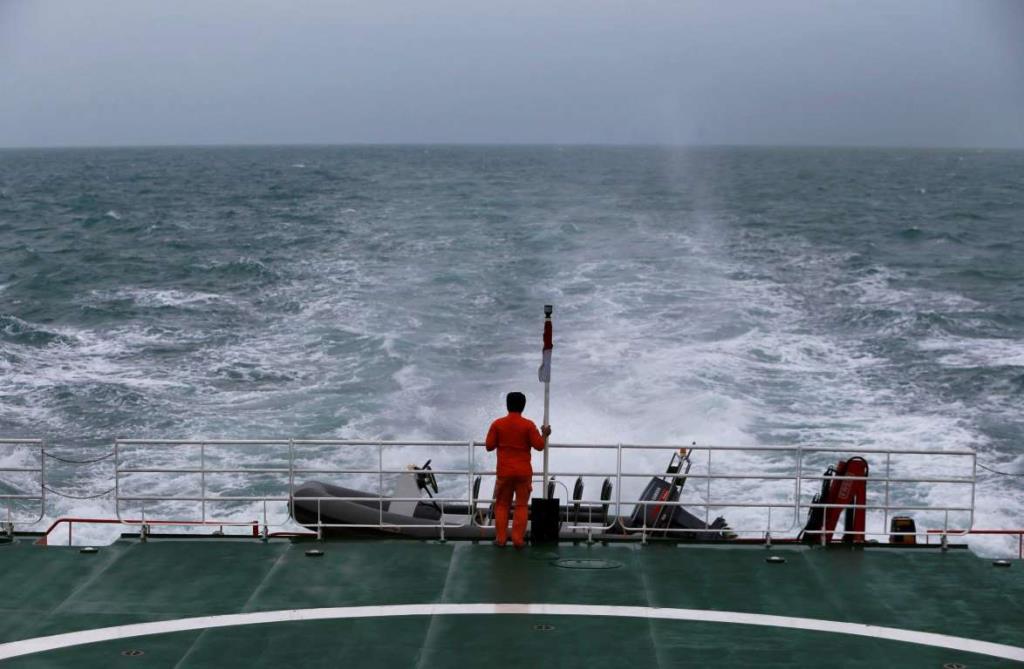January 3, 2014
JAKARTA/PANGKALAN BUN, Indonesia – Search teams hunting for the wreck of an AirAsia passenger jet that crashed with 162 people on board have found four large parts of the plane on the sea bed, the head of Indonesia's search and rescue agency said on Saturday.

January 3, 2014
JAKARTA/PANGKALAN BUN, Indonesia – Search teams hunting for the wreck of an AirAsia passenger jet that crashed with 162 people on board have found four large parts of the plane on the sea bed, the head of Indonesia's search and rescue agency said on Saturday.

A rescue member stands on the deck of SAR ship KN Purworejo during a search operation for passengers onboard AirAsia flight QZ8501, in Java Sea, Indonesia January 3, 2015.
A multi-national task force of ships, planes and helicopters have been scouring the northern Java Sea and coastline of southern Borneo to recover the bodies of victims and locate the wreck of Flight QZ8501 and its black box flight recorders.
"We've found four big parts from the plane we're looking for," search and rescue agency chief Fransiskus Bambang Soelistyo told reporters in Jakarta.
The breakthrough came as authorities said that Indonesia AirAsia had violated the terms of its licence for the Surabaya to Singapore route by flying on a Sunday, the day the Airbus A320-200 plunged into the Java Sea, and announced they would investigate the carrier's other schedules.
One large object was pinpointed by a ship searching during the night, Soelistyo said, and three more, the largest of which was around 18 metres long, were located on Saturday.
Another official, Supriyadi, who is coordinating the operation from the port of Pangkalan Bun in Borneo, said earlier that poor visibility had hampered efforts to capture images of the objects with underwater remote operating vehicles (ROVs).
"The visibility is only two metres," he said. "It's cloudy, making it difficult for the cameras to detect."
Divers, including a team of Russian specialists who just arrived in Pangkalan Bun, may be able to investigate the suspected wreckage on Sunday if the weather improves, officials said.
NO SURVIVORS
No survivors have been found from the crash, which happened about 40 minutes after the plane took off from Indonesia's second largest city in an area known for intense tropical thunderstorms during the current monsoon season.
A report from Indonesia's weather bureau said it was likely the plane had flown into bad weather which would have been difficult to avoid, and that it was possible this had caused ice to form on its engines.
"Based on the available data on the last received location of the aircraft, the weather was a factor in causing the accident," the weather bureau said.
Indonesian authorities on Friday questioned whether the pilot had followed correct weather procedures, and later suspended Indonesia AirAsia's Surabaya to Singapore flights, saying the airline's operating licence only permitted flights on Mondays, Tuesdays, Thursdays and Saturdays.
Djoko Murdjatmodjo, Indonesia's acting Director General of Air Transportation, said on Saturday that the Transport Ministry would investigate other routes used by the carrier, which flies from at least 15 Indonesian destinations.
"We are going to investigate all AirAsia flight schedules. Hopefully we can start on next Monday," he said. "It is possible AirAsia's licence in Indonesia might be revoked," he added.
Sunu Widyatmoko, Indonesia AirAsia chief, told reporters the airline, which is 49-percent owned by Malaysia-based AirAsia, would cooperate with the inquiry.
"The government has suspended our flights from Surabaya to Singapore and back," he said. "They are doing the evaluation process. AirAsia will cooperate fully with the evaluation."
Much effort has focused on finding the mostly Indonesian victims of the crash. Thirty bodies have been recovered from the sea, although rescue official Supriyadi, who like many Indonesians uses just one name, said it was unlikely more would be found floating.
"Because we're already in the seventh day … the chances are they have all sunk," he said. "There's a possibility they'll be found on beaches."
Small pieces of the aircraft and other debris have also been found, but there has been no sign of the crucial voice and flight data recorders – the so-called black boxes that investigators hope will unravel the sequence of events in the cockpit during the doomed jet's final minutes.
WEATHER FACTOR
The cause of the crash, the first fatal accident suffered by the AirAsia group, remains unexplained.
The plane was flying at 32,000 ft (9,753 metres) and the pilot had asked to climb to 38,000 ft just before contact was lost. When air traffic controllers granted permission to fly at 34,000 ft a few minutes later there was no response.
A source close to the investigation said radar data appeared to show the aircraft made an "unbelievably" steep climb before it crashed, possibly pushing it beyond the A320's limits.
Hadi Mustofa Djuraid, a transport ministry official, told reporters on Friday that authorities were also investigating the possibility that the pilot did not ask for a weather report from the meteorological agency at the time of take-off.
Indonesia AirAsia said in a statement that weather reports were printed in hard copy at the operations control centre at all its flight hubs, including Surabaya, and taken by the pilot to the aircraft before each flight.
An AirAsia spokeswoman declined to comment on whether the pilot had followed the procedure described in the statement.
Courtesy: Reuters
















































































































